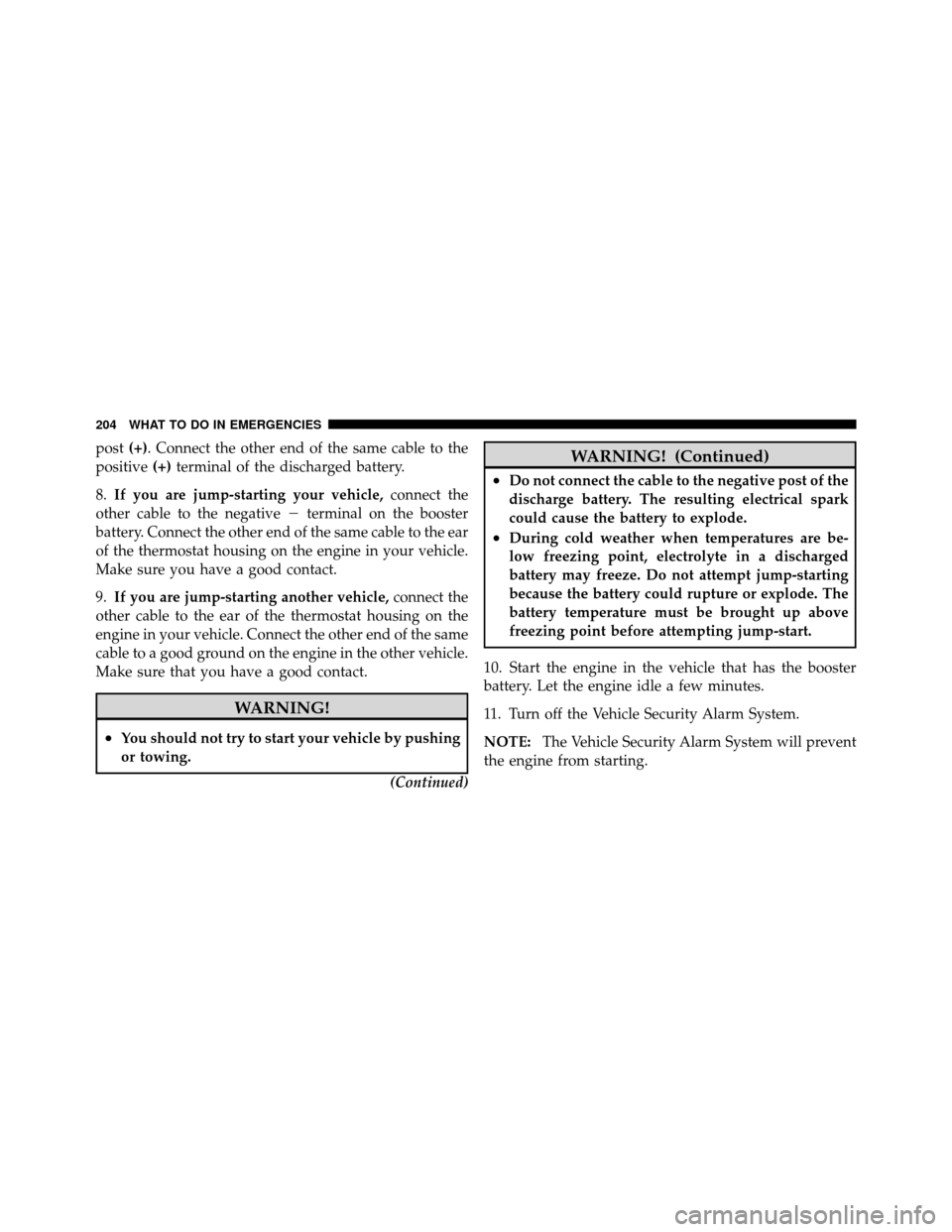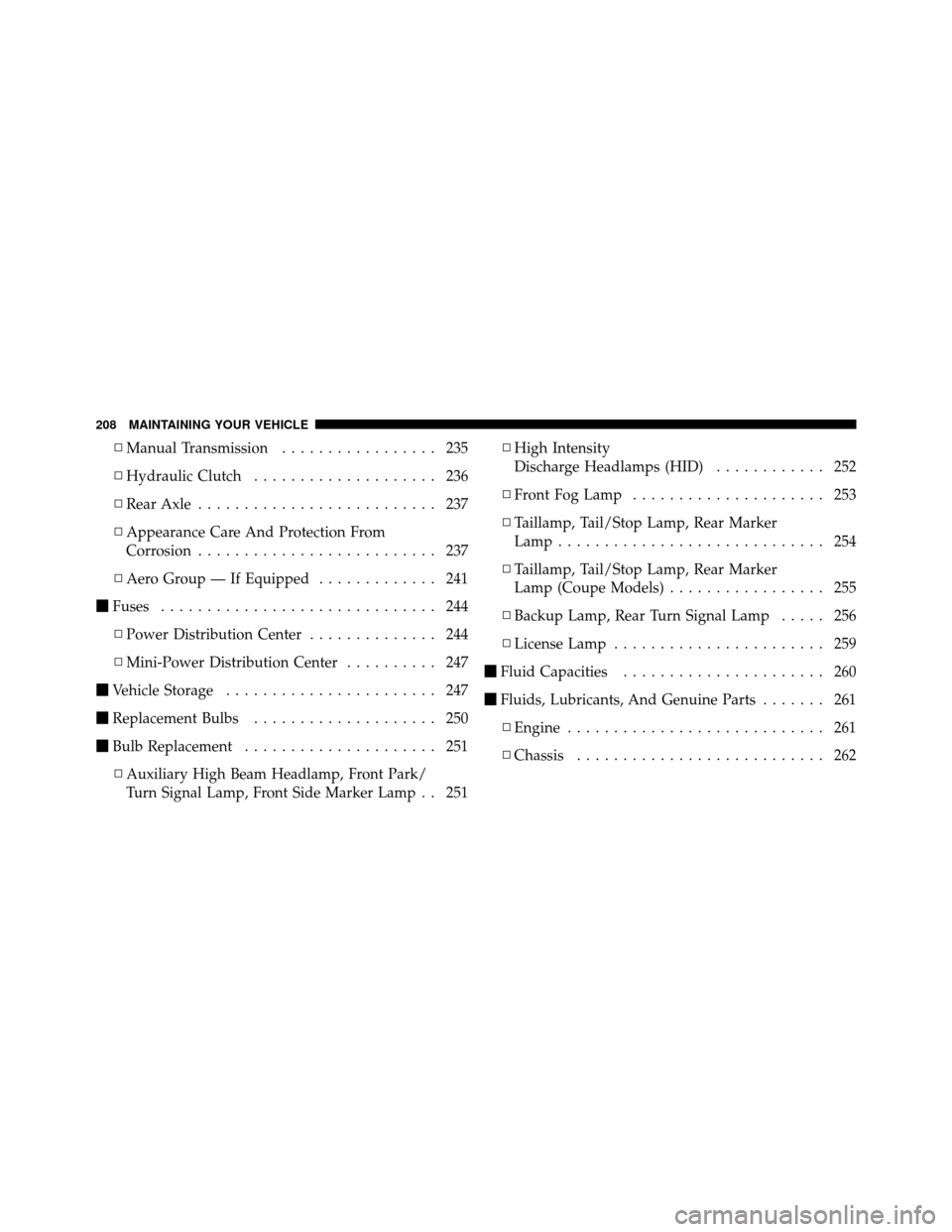Page 202 of 315

2. Connect the Power Plug (8) to a different 12 Volt
power outlet in your vehicle or another vehicle, if avail-
able. Make sure the engine is running before turning ON
the TIREFIT kit.
3. The Sealant Bottle (1) may be empty due to previous
use. Call for assistance.
NOTE:If the Mode Select Knob (5) is on air mode and
pump is operating, air will dispense from the Air Pump
Hose (7) only, not the Sealant Hose (6).
If the sealant (white fluid) does flow through the
Sealant Hose (6):
1. Continue to operate pump until sealant is no longer
flowing through hose (typically takes 30 - 70 seconds). As
the sealant flows through the Sealant Hose (6), the
Pressure Gauge (3) can read as high as 70 psi (5 Bar). The Pressure Gauge (3) will decrease quickly from approxi-
mately 70 psi (5 Bar) to the actual tire pressure when the
Sealant Bottle (1) is empty.
2. The pump will start to inject air into the tire immedi-
ately after the Sealant Bottle (1) is empty. Continue to
operate pump and inflate the tire to the pressure indi-
cated on the tire pressure label on the driver-side latch
pillar (recommended pressure). Check the tire pressure
by looking at the Pressure Gauge (3).
If the tire does not inflate to at least 26 psi (1.8 Bar)
pressure within 15 minutes:
•The tire is too badly damaged. Do not attempt to drive
the vehicle further. Call for assistance.
NOTE: If the air pump is equipped with a Deflation
Button and the tire becomes over-inflated, press the
Deflation Button to reduce the tire pressure to the
recommended inflation pressure before continuing.
198 WHAT TO DO IN EMERGENCIES
Page 206 of 315

JUMP-STARTING PROCEDURES
WARNING!
•Take care to avoid the radiator cooling fans when-
ever the hood is raised. They can start anytime the
ignition switch is on. You can be hurt by the fans.
•Take care to avoid the accessory drive whenever
the hood is raised. You can be hurt by the moving
components.
•Do not attempt to push or tow your vehicle to get
it started. Unburned fuel could enter the catalytic
converter and once the engine has started, ignite
and damage the converter and vehicle. If the
vehicle has a discharged battery, booster cables
may be used to obtain a start from a booster
battery or the battery in another vehicle. This type
of start can be dangerous if done improperly, so
follow this procedure carefully.(Continued)
WARNING! (Continued)
•Battery fluid is a corrosive acid solution; do not
allow battery fluid to contact eyes, skin, or cloth-
ing. Do not lean over a battery when attaching
clamps or allow the clamps to touch each other. If
acid splashes in eyes or on skin, flush contami-
nated area immediately with large quantities of
water.
•A battery generates hydrogen gas, which is flam-
mable and explosive. Keep flame or spark away
from the vent holes.
•Do not use a booster battery or any other booster
source with an output that exceeds 12 Volts.
NOTE: The battery is located underneath an access
panel inside the rear compartment on the left side of the
vehicle. A remote battery terminal is located in the engine
compartment for jump-starting.
202 WHAT TO DO IN EMERGENCIES
Page 207 of 315

1. Wear eye protection and remove any metal jewelry
such as watchbands or bracelets that might make an
inadvertent electrical contact.
2. When boost is provided by a battery in another
vehicle, park that vehicle within booster cable reach, but
without allowing the vehicles touch one another.
3. Set the parking brake, place the transmission in NEU-
TRAL, and turn the ignition OFF on both vehicles.
4. Turn off the heater, radio, and all unnecessary electri-
cal loads.
5. Remove the plastic cover from the remote jump-start
positive post(+)in the engine compartment. Refer to the
following illustration for remote jump-starting connec-
tions. 6.
If you are jump-starting your vehicle, connect one
end of a jumper cable to the positive (+)terminal on the
booster battery. Connect the other end of the same cable
to the remote jump-start positive post (+).
7. If you are jump-starting another vehicle, connect one
end of a jumper cable to the remote jump-start positive
Remote Jump-Start Connections6
WHAT TO DO IN EMERGENCIES 203
Page 208 of 315

post(+). Connect the other end of the same cable to the
positive (+)terminal of the discharged battery.
8. If you are jump-starting your vehicle, connect the
other cable to the negative �terminal on the booster
battery. Connect the other end of the same cable to the ear
of the thermostat housing on the engine in your vehicle.
Make sure you have a good contact.
9. If you are jump-starting another vehicle, connect the
other cable to the ear of the thermostat housing on the
engine in your vehicle. Connect the other end of the same
cable to a good ground on the engine in the other vehicle.
Make sure that you have a good contact.
WARNING!
•You should not try to start your vehicle by pushing
or towing.
(Continued)
WARNING! (Continued)
•Do not connect the cable to the negative post of the
discharge battery. The resulting electrical spark
could cause the battery to explode.
•During cold weather when temperatures are be-
low freezing point, electrolyte in a discharged
battery may freeze. Do not attempt jump-starting
because the battery could rupture or explode. The
battery temperature must be brought up above
freezing point before attempting jump-start.
10. Start the engine in the vehicle that has the booster
battery. Let the engine idle a few minutes.
11. Turn off the Vehicle Security Alarm System.
NOTE: The Vehicle Security Alarm System will prevent
the engine from starting.
204 WHAT TO DO IN EMERGENCIES
Page 209 of 315

12. Start the engine in the vehicle with the discharged
battery. If engine does not start in 15 seconds, stop
cranking engine and allow starter to cool down before
cranking again.
13. When removing the booster cables, reverse the above
sequence exactly. Be careful of the moving belts and fans.
WARNING!
Any procedure other than above could result in:
•Personal injury caused by electrolyte squirting out
the battery vent.
•Personal injury or property damage due to battery
explosion.
•Damage to charging system of booster vehicle or
of immobilized vehicle.
FREEING A STUCK VEHICLE
If your vehicle becomes stuck in mud, sand, or snow, it
can often be moved by a rocking motion. Turn your
steering wheel right and left to clear the area around the
front wheels. Then shift back and forth between RE-
VERSE and FIRST gear. Using the least accelerator pedal
pressure to maintain the rocking motion without spin-
ning the wheels is most effective.
CAUTION!
•When “rocking” a stuck vehicle by moving be-
tween 1st and REVERSE, do not spin the wheels
faster than 15 mph (24 km/h), or drivetrain damage
may result.(Continued)6
WHAT TO DO IN EMERGENCIES 205
Page 210 of 315
CAUTION! (Continued)
•Revving the engine or spinning the wheels too fast
may lead to transmission overheating and failure.
It can also damage the tires. Do not spin the
wheels above 30 mph (48 km/h) while in gear (no
transmission shifting occurring).
WARNING!
Fast spinning tires can be dangerous. Forces gener-
ated by excessive wheel speeds may cause damage, or
even failure, of the axle and tires. A tire could
explode and injure someone. Do not spin your vehi-
cle’s wheels faster than 30 mph (48 km/h) or for
longer than 30 seconds continuously without stop-
ping when you are stuck. And do not let anyone near
a spinning wheel, no matter what the speed.
TOWING A DISABLED VEHICLE
Do not tow with sling-type equipment. Only use flatbed
equipment. Always comply with applicable state or local
towing ordinances.
CAUTION!
Towing with equipment other than flatbed types may
damage your vehicle.
206 WHAT TO DO IN EMERGENCIES
Page 211 of 315
MAINTAINING YOUR VEHICLE
CONTENTS
�Engine Compartment — 8.4L ............. 209
� Onboard Diagnostic System (OBD II) ....... 210
� Emissions Inspection And Maintenance
Programs ............................ 211
� Replacement Parts ..................... 212
� Dealer Service ........................ 212
� Maintenance Procedures ................. 213
▫ Engine Oil ......................... 214
▫ Engine Oil Filter ..................... 216
▫ Engine Air Cleaner Filter ............... 216 ▫
Maintenance-Free Battery .............. 217
▫ Battery Save Feature .................. 219
▫ Air Conditioner Maintenance ............ 221
▫ Body Lubrication .................... 223
▫ Windshield Wiper Blades ............... 223
▫ Adding Washer Fluid ................. 224
▫ Exhaust System ..................... 224
▫ Cooling System ..................... 227
▫ Brake System ....................... 232
7
Page 212 of 315

▫Manual Transmission ................. 235
▫ Hydraulic Clutch .................... 236
▫ Rear Axle .......................... 237
▫ Appearance Care And Protection From
Corrosion .......................... 237
▫ Aero Group — If Equipped ............. 241
� Fuses .............................. 244
▫ Power Distribution Center .............. 244
▫ Mini-Power Distribution Center .......... 247
� Vehicle Storage ....................... 247
� Replacement Bulbs .................... 250
� Bulb Replacement ..................... 251
▫
Auxiliary High Beam Headlamp, Front Park/
Turn Signal Lamp, Front Side Marker Lamp
. . 251 ▫
High Intensity
Discharge Headlamps (HID) ............ 252
▫ Front Fog Lamp ..................... 253
▫ Taillamp, Tail/Stop Lamp, Rear Marker
Lamp ............................. 254
▫ Taillamp, Tail/Stop Lamp, Rear Marker
Lamp (Coupe Models) ................. 255
▫ Backup Lamp, Rear Turn Signal Lamp ..... 256
▫ License Lamp ....................... 259
� Fluid Capacities ...................... 260
� Fluids, Lubricants, And Genuine Parts ....... 261
▫ Engine ............................ 261
▫ Chassis ........................... 262
208 MAINTAINING YOUR VEHICLE